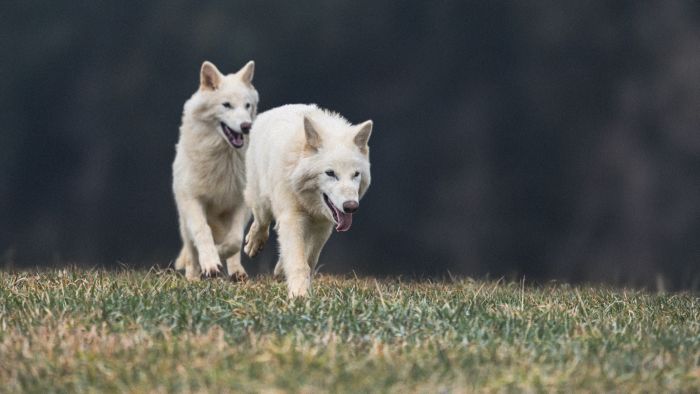Ears Up, Tails Wagging: Khaleesi Meets Her Dire Wolf Siblings for the First Time

In a carefully orchestrated moment that scientists at Colossal Biosciences had been planning for months, three dire wolves met face-to-face for the first time in over 12,000 years. The recent introduction between siblings Romulus, Remus, and Khaleesi marked a pivotal milestone in de-extinction science, with researchers closely monitoring behavioral cues to ensure successful pack formation.
The meeting took place in a six-acre grassy section of Colossal’s 2,000-acre ecological preserve, where animal husbandry manager Paige McNickle and her team observed critical social indicators that confirmed the wolves’ comfort and acceptance of one another.
Decoding Dire Wolf Body Language
The most significant behavioral observation came from a simple but telling detail: “Their ears were up the entire time, which is a good, happy, calm wolf behavior that we were hoping to see,” McNickle explained in footage documenting the historic encounter. This ear positioning, combined with consistent tail wagging and playful running, provided scientists with crucial data about dire wolf social communication patterns.
When Khaleesi first encountered Romulus, the interaction followed classic canine greeting protocols. The larger male approached his sister, they exchanged scents, and within moments, Khaleesi initiated play by taking off on a run with Romulus following. The sustained upright ear position throughout their interaction indicated sustained positive engagement rather than stress or aggression.
The behavioral patterns continued when Khaleesi met Remus separately. McNickle noted that “Remus is almost more gentle than Romulus” during their interaction, demonstrating individual personality differences that mirror those found in modern wolf populations. Both brothers maintained the same positive body language signals, suggesting consistent social recognition across the sibling group.
Strategic Pack Integration Using Environmental Controls
Colossal scientists designed the introduction environment to give Khaleesi maximum control over her interactions. The preserve area included fallen logs that the smaller female could slip under for refuge while her larger brothers could not follow. This environmental feature proved crucial during the meeting, as Khaleesi demonstrated remarkable intelligence by using the logs strategically.
“She’s an incredibly smart little dire wolf, and she was using the logs in the area to help her feel more secure,” McNickle observed. This behavior allowed Khaleesi to engage with her brothers when comfortable and retreat when overwhelmed, essentially controlling the pace and intensity of socialization.
The tactical use of environmental features for safety represents sophisticated problem-solving behavior that provides insights into dire wolf intelligence and adaptability. These observations help researchers understand how the extinct predators might have navigated complex social situations in the wild.
Building Confidence Through Gradual Socialization
Following the successful initial meetings, Colossal Biosciences implemented an alternating schedule where Khaleesi spends individual time with each brother on rotating days. This measured approach prioritizes the female’s psychological development and confidence building before attempting permanent cohabitation.
“We want her to feel like she’s controlling all of her interactions with them,” McNickle emphasized, highlighting the team’s commitment to animal welfare during this unprecedented scientific endeavor. The cautious methodology reflects decades of research in wolf behavior and pack dynamics.
The socialization strategy acknowledges the significant size difference between six-month-old Khaleesi and her brothers, who are approaching their first birthday and weigh over 90 pounds each. By allowing the female to build confidence gradually, scientists increase the likelihood of successful long-term pack cohesion.
Implications for De-Extinction Science
The positive behavioral indicators observed during these first meetings provide valuable data for future de-extinction projects. Understanding how genetically recreated species interact socially offers insights that extend beyond individual animal welfare to species-level conservation applications.
Colossal’s careful documentation of dire wolf social behaviors contributes to broader scientific understanding of extinct species behavioral patterns, information that could prove crucial as the company expands its de-extinction work to include other species like the woolly mammoth and Tasmanian tiger.
The successful integration of these dire wolf siblings represents more than a conservation milestone—it demonstrates the viability of recreating complex social structures in de-extinct species, opening new possibilities for ecosystem restoration and biodiversity conservation.



